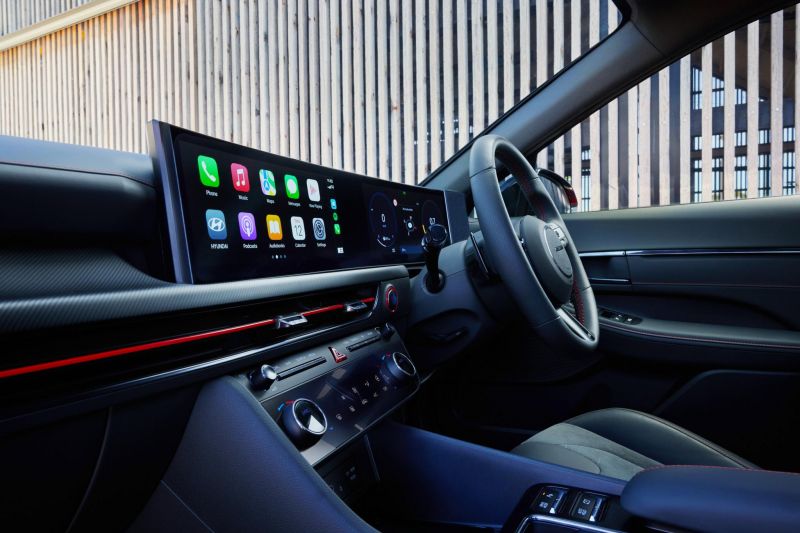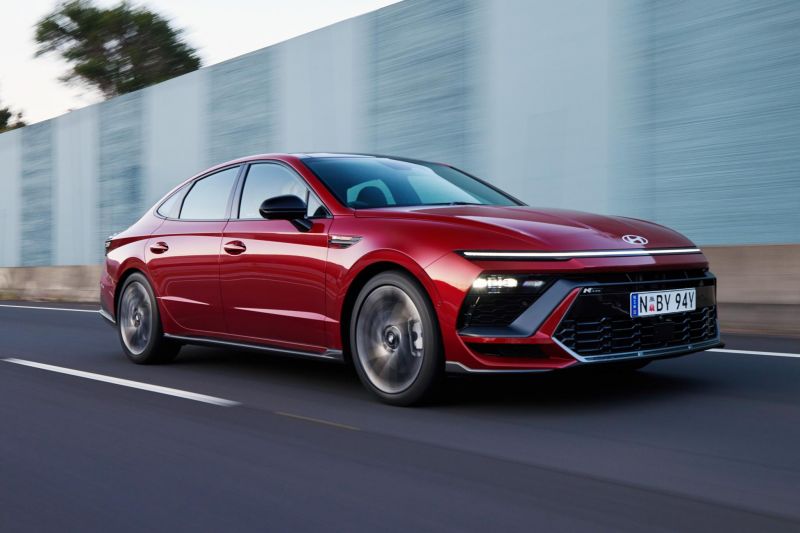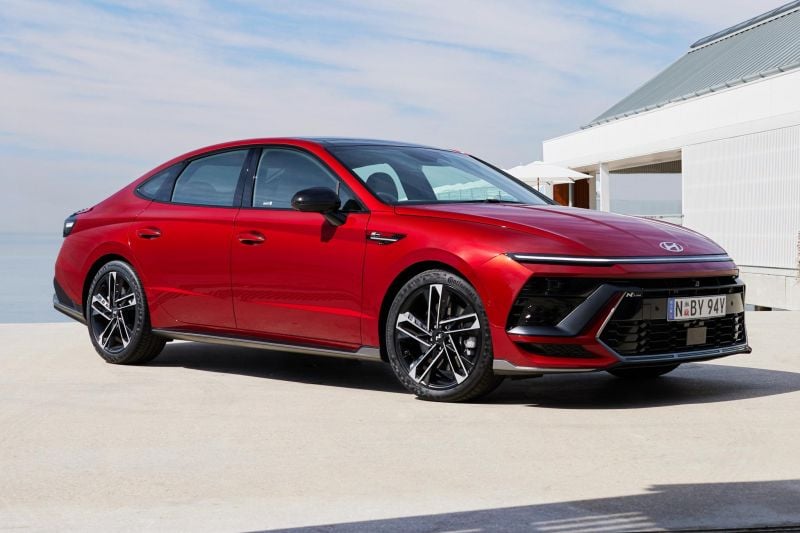The Hyundai Sonata has been an important part of the brand’s ranks for decades. We first got the Sonata way back in 1989 and it has been a part of the Hyundai range since then, though for a while there, it was called i45.
Sonata sales peaked way back in 2006, when Hyundai sold 3005 cars. At that stage, it was kind of like a Toyota Camry but from Korea – with a choice of V6 petrol or four-cylinder engines, front-wheel drive, and conservative styling.
Some things haven’t changed – it still competes with the Toyota, and it still has four-cylinder power. Now though, it’s turbocharged and tuned for performance in flagship N Line spec, which is all we get in Australia these days.
The conservative element? Long gone. The pre-facelift model was a ‘wow’ moment for the brand, but this upgraded model is by far the most radical version of the Sonata yet.
It’s also arguably the best Sonata ever. It takes what was already an impressive mid-sized sedan, but with a series of significant improvements to its design and styling inside and out, the 2024 Hyundai Sonata stands out for the right reasons.
But is it going to be right for you? Read on and you’ll find out.
How does the Hyundai Sonata fare vs its competitors?
View a detailed breakdown of the Hyundai Sonata against similarly sized vehicles.

Hyundai
Sonata
How much does the Hyundai Sonata cost?
The new-look Hyundai Sonata N Line has a slightly higher price than the last version.
At $55,500 plus on-road costs, that represents a modest (by-modern standards) jump from its predecessor, which most recently had a list price of $52,065.
There are no options to choose from, but some colours cost a little extra. The no-cost option is Serenity White, while Biophilic Ink (that beautiful dark purple colour you’ve seen on the Ioniq 6), Abyss Black, Nocturne Grey, Ultimate Red all add $595 to the price, and Aero Silver Matte costs an extra $1000.
Obviously you could be considering a Toyota Camry, but in recent weeks the brand has paused orders its staple sedan, and there’s an new version due soon. But it is still, arguably, the closest competitor, and the dominant offering in the market, too. It’s priced from just $34,320 for the base petrol, through to $50,320 for the top-spec luxury-sporty SL Hybrid.
If you’re after a sportier car, then the Skoda Octavia RS is a standout – with the liftback version listing from $51,890 and the wagon at $53,090. It’s a bit less dramatic in its design, but arguably a bit more youthful in its appeal.
Another established player in the market is the Mazda 6, also available as a sedan or wagon, from $36,140 to $55,535. High-grade models get a great turbo engine, but it’s not the most modern-feeling car these days.
And if modern is your cuppa, have a look at the new BYD Seal electric sedan, which starts from $49,888 and comes with 460km of WLTP rated range, and a damn-near identical list of standard equipment. There’s a faster one with longer range for a few grand over this Hyundai, too…
What is the Hyundai Sonata like on the inside?
The changes might be startling on the outside, but Hyundai has also smartened things up inside the cabin, too.
It feels very different because of the newly rethought dash area, with the curved housing for twin 12.3-inch digital screens making for plenty of wow-factor – just don’t get PTSD from the curved monitors at your office desk!
That new digital screen for the driver is a big upgrade, giving the Sonata N Line the option of different displays for different drive modes. It also provides Blind Spot View Monitor functionality that you will appreciate if you spend a lot of time on multi-lane roads.
The infotainment system has also seen a shift to the newer software layout seen in the Hyundai Kona, which is a step forward from the existing version, though if you’re like me, you will probably just connect your phone up and forget about all the great features built into the multimedia system.
You will learn your way around the menus for one function, though. The new speed-sign recognition system is a pain. More on that in the safety section.
The seats are comfortable, but I find them to be too high. The base of the seat never drops down far enough for me to get into a properly ‘sporty’ low-slung driving position. It’s a shame, because otherwise they’re great, and the material finishes are lovely.
Storage smarts are there, too, largely courtesy of the shifter being moved to the steering column, with decent-sized cupholders between the front seats, a wireless phone charging spot, and a good centre console bin. There are bottle holders in the doors, too.
Oh, that shifter does take some getting used to. It’s logical that you twist it forwards to go forwards, and backwards to reverse, but I constantly did the opposite!
Back seat space is accommodating unless you’re very tall. I had enough space to sit behind my own driving position (at 182cm/6’0), but headroom was a touch tight due to the large panoramic glass roof.
Knee room, toe space and shoulder room were all better than average, and there’s easily enough width to fit three adults across the back.
However, the middle-seat rider will have a bit of negotiating to do with the outboard riders when it comes to foot room, as there’s a slight rise in the floor level due to the transmission tunnel.
If your occupants are likely to be smaller, there are ISOFIX points in the window seats and three top-tether points as well. But sadly those in child seats won’t be able to enjoy the comfortable heated outboard seats until they are older.
At least anyone in the back will be shaded, thanks to side window-shades that can be deployed, and there’s a powered rear shade over the back windshield, too.
The Hyundai also has two USB-C ports, directional air vents, bottle holders in the doors and a flip-down armrest with cup holders.
Boot space – as you’d expect for a larger sedan – is good. There’s 510 litres of cargo capacity, and thankfully the Sonata’s gooseneck hinges are covered so they don’t smash into your stuff if the boot is fully loaded.
There’s a space-saver spare wheel under the boot floor too, and – I’m not sure why – there’s a powered tailgate. It does have the clever feature of opening up automatically when you have your keys in your pocket and you wait at the back of the car. Handy for parents!
What’s under the bonnet?
The changes might be big inside and out, but under the bonnet it’s the same Sonata we already had.
That means it gets the most powerful petrol engine available, a 2.5-litre T-GDi turbo-petrol four-cylinder producing 213kW of power and 422Nm of torque.
That’s a whole lot of grunt for a midsize model, and easily outdoes its price-rivalling petrol-powered alternatives in the segment. To get the power down, this front wheel drive Hyundai uses an eight-speed dual-clutch (wet clutch) automatic gearbox, with paddle-shifters.
Unlike the previous model, the new Sonata gets an EV-style column-mounted shift-by-wire selector, which can take some getting used to.
How does the Hyundai Sonata drive?
It doesn’t drive that much differently to the pre-facelift model; and if you’re after a slightly sporty, relatively quick sedan, that’s going to be just fine with you.
It’s not blisteringly fast, in the way some EVs for not much more money are, but it is quick enough. The 2.5-litre turbo-petrol engine offers a good amount of gusto, especially when you plant the throttle in the middle gears, and when you’re in the Sport drive mode.
The eight-speed dual-clutch auto is pretty well sorted at lower speeds, and doesn’t really behave like a DCT in those stop-start, slow-speed manoeuvres that can be tedious in other cars with DCTs.
There is some slight lag to work with, but you get used to it very quickly, and it takes off from a standstill with speed, too. Just be aware that, even with 245/40 R19 Continental Premium Contact tyres, it still can spin the front tyres even in the dry, because there’s so much grunt being fed to the front axle.
If you find the right road you’ll be able to enjoy the sound of this car, too, which is more aggressive than you might expect when you really open it up – there’s some noise piped into the cabin to make it feel a bit more theatrical.
I like the balance that Hyundai has struck with the steering, handling and ride comfort in the Sonata N Line.
There have been a bunch of new parts added and changes made – including a strengthened body structure, stronger front sub-frame, new subframe bushes, strut tower reinforcement, shorter rear bump stops, and new rear trailing-arm design – but no changes to the suspension tuning.
And honestly, that’s no big problem because the ride is firm but not harsh, and the body control is pretty good in most situations.
Even over broken, cruddy road surfaces like the ones around Wisemans Ferry that we tested the car on during the launch.
The steering also has a nice level of involvement with good weighting and responsiveness, meaning it’s a fair bit of fun in the twisty stuff, but also easy to park.
I like it, and I think you will too.
What do you get?
The standard equipment list has been increased for this updated Sonata N Line, in line with a slight price bump compared to the pre-facelift version.
Here’s a rundown of the spec highlights:
- 19-inch alloy wheels
- Now with tyre pressure monitoring, space-saver spare wheel
- LED headlights
- LED “Seamless Horizon Lamp” with DRLs, dynamic indicators
- LED tail-lights with elongated ‘H’ emblem
- N Line body kit
- Quad exhaust outlets
- Panoramic sunroof
- Leather and suede seat trim
- Heated, ventilated front seats
- Electric front seat adjustment
- 12-way driver, 4-way passenger
- Heated rear outboard seats
- 12.3-inch touchscreen media system
- Wired Apple CarPlay, Android Auto
- Satellite navigation with live connected mapping
- AM/FM/DAB radio
- 12.3-inch digital configurable driver info display
- New 6.6-inch touch panel for climate settings
- 64-colour ambient lighting
- Leather-appointed heated steering wheel with paddle-shifters
- Electric park brake
- Auto headlights with auto high-beam
- Auto wipers
- Wireless phone charger
- Bose 12-speaker stereo system
- Auto-dimming rearview mirror
- Acoustic front glass
- Tinted rear windows
- Power opening rear sunshade
- Side shades for rear passengers
- Power boot lid
- Surround view cameras
- Extensive standard safety technology (see below)
It’s fair to say that this is a very well equipped vehicle, even given its $55,000-plus price tag.
Is the Hyundai Sonata safe?
If you’re the sort of person who insists on an ANCAP rating to call a car ‘safe’, then you’re going to rule this one out – there is no current ANCAP or Euro NCAP rating for the Sonata.
But in this writer’s opinion, that doesn’t make the car unsafe. Not by any stretch. The Sonata has an abundance of safety technology and equipment, including a few new items for 2024 and beyond.
Standard safety equipment includes:
- Autonomous Emergency Braking (AEB)
- Car-to-Car, Motorcycle
- Pedestrian, Cyclist detection
- Junction assist
- Lane departure warning
- Lane keep assist
- Adaptive cruise control
- Blind-spot assist
- Blind Spot View Monitor
- Rear cross-traffic assist
- Safe Exit Assist
- Front, rear parking sensors
- Surround-view cameras
Also under the safety category is the most annoying ‘upgrade’ to this car – the Intelligent Speed Limit Assist function, which can read the speed limit signage using a camera.
It will ‘bing’ every time the speed changes (it does that more often than you’d think!) and will repeatedly ‘bing’ at you if you’re going even a kilometre over that signposted number. It is easily the most frustrating piece of new-car technology this writer has experienced, and switching it off is a real task. You need to do so every time you drive the car, and it takes several touches of the infotainment screen to do so.
I’ve heard people who have bought Hyundai Palisade and Kona models, and the Kia Seltos too, tell me that they have had to get rid of their car as this tech is so frustrating to live with. Okay – rant over.
Also worth noting is that this car only comes with six airbags – dual front, front side and full-length curtain. No driver’s knee, and no front-centre airbag.
How much does the Hyundai Sonata cost to run?
Hyundai Australia offers a five-year, unlimited kilometre warranty, and the brand also has a pretty impressive service setup too – apart from the maintenance intervals.
That’s because this turbo engine requires attention every 12 months/10,000km, which is shorter than plenty of other rivals in terms of kays covered. But there is a capped-price servicing plan for the life of the car, and the first five services are capped at $350 per visit.
If you service with Hyundai there’s roadside assistance that gets topped up yearly too, for up to a decade. And, there’s 10 years of sat-nav mapping updates included as well. Because this updated model also scores Hyundai’s BlueLink connected services, buyers receive five years of data connection at no cost.
The functions covered under BlueLink include Emergency Services calling (if you have a crash and airbags deploy, the car will initiate a call for help), Connected Routing (using cloud-based data to predict traffic issues), weather updates, and app-based connectivity features like car check-ups and even remote access to your car’s surround-view camera to check on the surroundings.
The BlueLink system also includes over-the-air (OTA) updates, which could limit the number of trips you need to make to the dealership.
As for fuel costs, don’t expect it to be Camry Hybrid-like in its consumption. The official combined cycle fuel use number is 8.1 litres per 100km, which is the same as the pre-update model, despite some changes to the urban and extra-urban figures.
On the launch drive with Hyundai, which covered a few hundred kilometres of mostly rural and open road driving, I saw an indicated return of 9.3L/100km displayed.
CarExpert’s Take on the Hyundai Sonata
While there are many carryover elements, this almost feels like an all-new car, and that’s to its benefit.
The Sonata has new looks, new tech and almost a new persona, which now offers more appeal to a broader range of potential customers.
It’s not perfect – the safety sign system could seriously be a dealbreaker for some – but it is a very compelling choice for those who want a petrol-powered sporty sedan, and want to stand out from the crowd.
Click the images for the full gallery
BUY: Hyundai Sonata
MORE: Everything Hyundai Sonata













